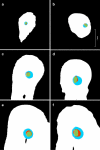Micro-CT evaluation of rotary and reciprocating glide path and shaping systems outcomes in maxillary molar curved canals
- PMID: 34173078
- PMCID: PMC8732797
- DOI: 10.1007/s10266-021-00631-2
Micro-CT evaluation of rotary and reciprocating glide path and shaping systems outcomes in maxillary molar curved canals
Abstract
The shaping outcomes after instrumentation with rotary and reciprocating glide path and shaping systems were evaluated through micro-computed tomography (Micro-CT). Thirty extracted maxillary first molars were selected. Mesio-buccal canals were randomized into two groups (n = 15): rotary system ProGlider and ProTaper Next X1, X2 (PG-PTN) and reciprocating system WaveOne Gold Glider and WaveOne Gold Primary (WOGG-WOG). Specimens were micro-CT scanned before, after glide path and after shaping. Increase in canal volume and surface area, percentage of removed dentin from the inner curvature, centroid shift and canal geometry variation through ratio of diameter ratios (RDR) and ratio of cross-sectional areas (RA) were measured in the apical and coronal levels and at the point of maximum curvature. The number of pecking motions needed to reach the working length (WL) was recorded. One-way ANOVA and post hoc Turkey-Kramer tests were used (p < 0.05). Post-glide path analysis revealed that in the coronal third, RDR was more favorable to PG and centroid shift was lower for WOGG in the apical third. Post-shaping analysis showed a reduced removal of dentin and a more favorable RA for PTN at point of maximum curvature. The number of pecking motions up to WL resulted in different between groups both for glide path and shaping phases. Despite a higher dentin removal for reciprocating instruments at the point of maximum curvature, both systems seemed to produce well-centered glide path and shaping outcomes. Rotary and reciprocating systems seemed able to respect the original canal anatomy.
Keywords: Glide path; Micro-CT; Reciprocating system; Rotary system; Shaping outcomes.
© 2021. The Author(s).
Conflict of interest statement
The authors declare that they have no conflicts of interest.
Figures

Similar articles
-
Glide Path in Endodontics: A Literature Review of Current Knowledge.Dent J (Basel). 2024 Aug 14;12(8):257. doi: 10.3390/dj12080257. Dent J (Basel). 2024. PMID: 39195101 Free PMC article. Review.
-
Micro-CT evaluation of several glide path techniques and ProTaper Next shaping outcomes in maxillary first molar curved canals.Int Endod J. 2017 Apr;50(4):387-397. doi: 10.1111/iej.12628. Epub 2016 Apr 15. Int Endod J. 2017. PMID: 26990141
-
Root Canal Shaping Using Nickel Titanium, M-Wire, and Gold Wire: A Micro-computed Tomographic Comparative Study of One Shape, ProTaper Next, and WaveOne Gold Instruments in Maxillary First Molars.J Endod. 2019 Jan;45(1):62-67. doi: 10.1016/j.joen.2018.09.013. Epub 2018 Nov 13. J Endod. 2019. PMID: 30446405
-
Microcomputed Assessment of Transportation, Centering Ratio, Canal Area, and Volume Increase after Single-file Rotary and Reciprocating Glide Path Instrumentation in Curved Root Canals: A Laboratory Study.J Endod. 2019 Jun;45(6):791-796. doi: 10.1016/j.joen.2019.02.012. Epub 2019 Mar 30. J Endod. 2019. PMID: 30935620
-
Influence of Negotiation, Glide Path, and Preflaring Procedures on Root Canal Shaping-Terminology, Basic Concepts, and a Systematic Review.J Endod. 2020 Jun;46(6):707-729. doi: 10.1016/j.joen.2020.01.023. Epub 2020 Apr 22. J Endod. 2020. PMID: 32334856
Cited by
-
Comparative Study of the SEM Evaluation, EDX Assessment, Morphometric Analysis, and Cyclic Fatigue Resistance of Three Novel Brands of NiTi Alloy Endodontic Files.Int J Environ Res Public Health. 2022 Apr 6;19(7):4414. doi: 10.3390/ijerph19074414. Int J Environ Res Public Health. 2022. PMID: 35410096 Free PMC article.
-
Micro-Computed Tomography Evaluation of Minimally Invasive Shaping Systems in Mandibular First Molars.J Clin Med. 2022 Aug 8;11(15):4607. doi: 10.3390/jcm11154607. J Clin Med. 2022. PMID: 35956222 Free PMC article.
-
Glide Path in Endodontics: A Literature Review of Current Knowledge.Dent J (Basel). 2024 Aug 14;12(8):257. doi: 10.3390/dj12080257. Dent J (Basel). 2024. PMID: 39195101 Free PMC article. Review.
-
Influence of Cavity Designs on Fracture Resistance: Analysis of the Role of Different Access Techniques to the Endodontic Cavity in the Onset of Fractures: Narrative Review.ScientificWorldJournal. 2024 Jul 30;2024:1648011. doi: 10.1155/2024/1648011. eCollection 2024. ScientificWorldJournal. 2024. PMID: 39109329 Free PMC article. Review.
-
Comparison of mechanical properties and shaping performance of ProGlider and ProTaper ultimate slider.BMC Oral Health. 2025 Jan 11;25(1):59. doi: 10.1186/s12903-025-05422-7. BMC Oral Health. 2025. PMID: 39799311 Free PMC article.
References
-
- Schilder H. Cleaning and shaping the root canal. Dent Clin North Am. 1974;18:269–296. - PubMed
-
- Peters OA. Current challenges and concepts in the preparation of root canal systems: a review. J Endod. 2004;30:559–567. - PubMed
-
- Bürklein S, Schäfer E. Critical evaluation of root canal transportation by instrumentation. Endod Top. 2013;29:110–124.
-
- Berutti E, Negro AR, Lendini M, Pasqualini D. Influence of manual preflaring and torque on the failure rate of ProTaper rotary instruments. J Endod. 2004;30:228–230. - PubMed
-
- Patiño PV, Biedma BM, Liébana CR, Cantatore G, Bahillo JG. The influence of a manual glide path on the separation rate of NiTi rotary instruments. J Endod. 2005;31:114–116. - PubMed
MeSH terms
Substances
LinkOut - more resources
Full Text Sources

